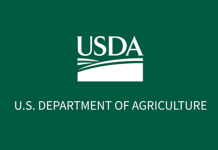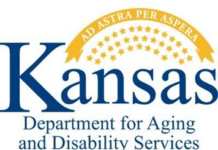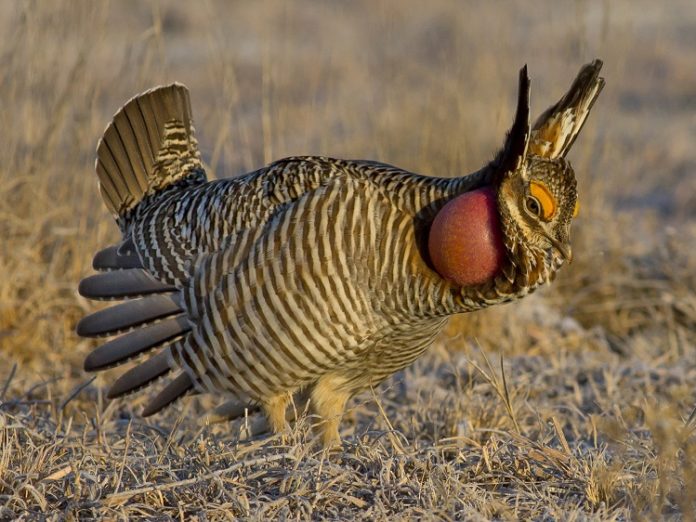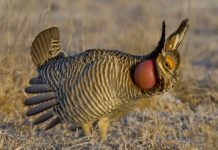(Updated to include comments from Livestock Association, Gov. Kelly, Sen. Marshall and Rep. Estes and Sierra Club)
Federal environmental regulators are classifying the lesser prairie chicken as threatened in Kansas under the Endangered Species Act, a move that critics have said would hurt the state’s rural economy.
The U.S. Fish and Wildlife Service announced the listing on Thursday after first revealing the proposed protections for the bird – known for its feathered feet and stout build – more than a year ago.
The decision was criticized by livestock interests, Republican members of the Kansas congressional delegation as well as Democratic Gov. Laura Kelly, while praised by environmentalists.
“The lesser prairie-chicken’s decline is a sign our native grasslands and prairies are in peril,” said Amy Lueders, southwest regional director for the Fish and Wildlife Service.
“These habitats support a diversity of wildlife and are valued for water quality, climate resilience, grazing, hunting and recreation,” Lueders said.
The action was quickly criticized by the U.S. Sen. Roger Marshall, who called it “disappointing.”
“Listing the lesser prairie chicken will hurt our state’s economy, hinder our oil and gas independence, increase utility costs, and prevent the development of renewable energy in prime western Kansas locations,” Marshall said in a statement.
Kelly, whose administration had opposed the protections for the lesser prairie chicken last year, shared similar concerns.
“At a time when we should be doing everything we can to lower energy and food prices, I share the concerns of the Kansas renewable energy, oil and gas, and agriculture industries regarding the potential impact this will have on our state,” Kelly said.
“I will continue to advocate for the affected industries and work to protect Kansans from the economic impacts of this rule,” Kelly said in a statement.
The lesser prairie chicken is a species of prairie grouse that occupies a five-state range including portions of Texas, New Mexico, Oklahoma, Kansas and Colorado.
Federal regulators divided up the region into where the bird would be considered “endangered” or “threatened.”
Fish and Wildlife listed the birds as “endangered” in eastern New Mexico and in the western part of the Texas panhandle, where there are believed to be as few as 5,000 birds remaining, with the count dropping to as low as 1,000 birds in 2015.
The bird would be listed as “threatened” in southcentral and southwestern Kansas, southeastern Colorado, western Oklahoma and the northeast Texas Panhandle.
Regulators said the prairie chicken is not currently in danger of extinction in those northern areas but is likely to become at risk of extinction within the foreseeable future throughout all of its range.
The lesser prairie chicken’s population has dwindled by 90% since the 1800s.
A 2020 study done by the Western Association of Fish and Wildlife Agencies, however, estimated the bird’s population at 34,408, an increase from 33,094 in 2018.
The population has more than doubled from 15,397 in 2015, the study showed.
While historical estimates suggest lesser prairie chickens once numbered in the hundreds of thousands, or even millions, across nearly 100 million acres, environmental regulators said the populations have declined drastically due to habitat loss and fragmentation.
Aerial surveys from 2012 through 2022 estimate a five-year average lesser prairie chicken population of 32,210 across the five-state region.
“Their decline reflects the larger decline in the vitality and resilience in shinnery oak, sand sagebrush and mixed- and short-grass prairie ecosystems,” the Fish and Wildlife Service said in a statement.
Zack Pistora, lobbyist for the Sierra Club and board president of the Kansas Rural Center, said the implications of the bird’s declining population for nature should override the ramifications for business.
“The peril of the lesser prairie chicken is just one indicator of the harm we’ve caused to our natural environment,” Pistora said in an email.
“Throwing nature out-of-whack is costing us much more than the narrow disruptions to business we often hear some complain about.”
The distinction between “endangered” and “threatened” is significant because of the regulations each could bring with it to the state’s economic development interests.
The federal government defines “endangered” species as one at risk of extinction throughout all or a significant portion of its range.
A “threatened” species is one that is likely to become endangered within the foreseeable future throughout all or a significant portion of its range.
Federal regulations protect “endangered species” from being killed or harmed without federal authorization.
All of the protections of the Endangered Species Act are afforded to a species listed as “endangered.”
Meanwhile, federal regulators have more flexibility for “threatened species” so they can write rules that would require conservation efforts of any activity that might intrude on the lesser prairie chicken’s habitat.
Last year, Kelly’s administration had urged the federal government not to impose new protections for the lesser prairie chicken, saying the states are in the best position to protect the bird’s habitat.
The Kansas Department of Wildlife and Parks told regulators that the lesser prairie chicken didn’t warrant additional federal protections that would come with being listed as threatened under the Endangered Species Act.
“The available information does not indicate the species is ‘likely to become an endangered species within the foreseeable throughout all or a significant portion of its range,’” the Wildlife Secretary Brad Loveless wrote.
Loveless said a federal decision to step in and impose more protections – above and beyond what Kansas law already provides – would interfere with state efforts to protect the bird and breed distrust with landowners.
“Whether a listing is determined to be warranted or not, the state wildlife management agencies remain the best source of management authority and conservation actions” for the lesser pairie chicken, Loveless wrote to the agency.
The secretary said the U.S. Fish and Wildlife Service doesn’t have the staff in Kansas – or anywhere else for that matter – to do the work needed to preserve the bird’s habitat.
“State wildlife management agencies have the technical expertise and longstanding relationships with landowners that is necessary to accomplish the task of increasing habitat quality and reversing habitat loss trends,” Lovelesss wrote.
Eight years ago, the U.S. Fish and Wildlife Service listed the lesser prairie chicken as threatened under the Endangered Species Act.
However, a federal court set aside those protections after it found that the agency failed to properly evaluate the effect of voluntary conservation efforts to protect the bird.
The Kansas Livestock Association had opposed to the listing, saying it prefers voluntary efforts to preserve the bird’s habitat.
“It appears the FWS is playing politics with what should be a science-based listing,” Livestock Association CEO Matt Teagarden said in a statement last year when the new rule was proposed by the government.
“The agency’s previous attempt to list the species was struck down by a federal court for ignoring voluntary conservation efforts,” Teagarden said.
“It appears once again, the agency has ignored voluntary conservation efforts that have helped double the species population without a government mandate.”
The Kansas Livestock Association also expressed worry about a rule that accompanies the listing that will only provide exemptions for ranchers after a grazing management plan has been developed by an agency-approved third party.
“This unnecessarily penalizes cattle ranchers, whose land is a major reason the bird thrives today, by subjecting their management decisions to the whims of a bureaucrat with no connection to the land,” said Aaron Popelka, vice president of legal and governmental affairs for the Livestock Association.
Republican Congressman Ron Estes said the rule is “detrimental to Kansas communities and our robust ag and energy industry.”
“Our Kansas ranchers and producers are the ones who have been excellent stewards of land and resources and certainly don’t need federal bureaucrats a thousand miles away to intervene,” Estes said.
















